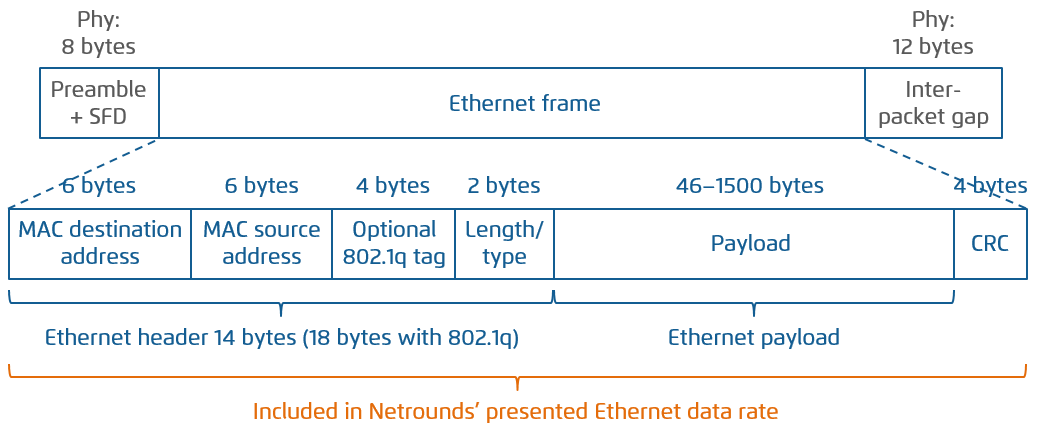Theoretical maximum throughput with Routing Active Testing Test Agents¶
This article discusses theoretical maximum throughput in Routing Active Testing as compared to line rate, differences being due to protocol overhead. We frame our theoretical reasoning in the context of Test Agents and their expected maximum performance. Besides overhead, there are other limiting factors which are not considered here, such as CPU limitations and overbooking of network links.
Theoretical performance is calculated for Ethernet and for TCP and UDP over Ethernet. Read more about Ethernet frame sizes here.
Ethernet data rates¶

The following table shows theoretical maximum Ethernet data rates in Routing Active Testing UDP performance tests as percentages of the line rate. In these calculations, the header and CRC are included in the data rate. This is also the basis for the absolute Ethernet data rates presented in Routing Active Testing.
Protocol |
Ethernet overhead (bytes) |
Theor. max. data rate (%) |
|---|---|---|
Ethernet, no 802.1q,
MTU = 1500 bytes
|
8 preamble + 14 header + 4 CRC
+ 12 gap = 38 bytes/packet
|
(1500 + 18) / (1500 + 38)
= 98.6996%
|
Ethernet, no 802.1q,
MTU = 494 bytes
|
8 preamble + 14 header + 4 CRC
+ 12 gap = 38 bytes/packet
|
(494 + 18) / (494 + 38)
= 96.2406%
|
Ethernet, no 802.1q,
MTU = 46 bytes
|
8 preamble + 14 header + 4 CRC
+ 12 gap = 38 bytes/packet
|
(46 + 18) / (46 + 38)
= 76.1905%
|
Ethernet with 802.1q,
MTU = 1500 bytes
|
8 preamble + 18 header + 4 CRC
+ 12 gap = 42 bytes/packet
|
(1500 + 22) / (1500 + 42)
= 98.7030%
|
Ethernet with 802.1q,
MTU = 494 bytes
|
8 preamble + 18 header + 4 CRC
+ 12 gap = 42 bytes/packet
|
(494 + 22) / (494 + 42)
= 95.5224%
|
Ethernet with 802.1q,
MTU = 46 bytes
|
8 preamble + 18 header + 4 CRC
+ 12 gap = 42 bytes/packet
|
(46 + 22) / (46 + 42)
= 72.7273%
|
TCP over Ethernet data rates¶

The following table shows theoretical maximum TCP data rates in Routing Active Testing TCP performance tests as percentages of the line rate. In these calculations, only TCP data (“Data” in the above figure) counts as payload. This is also how absolute TCP data rates are presented in Routing Active Testing.
It is assumed throughout that no header compression takes place.
Protocol |
TCP/IP overhead (bytes) |
Theor. max. data rate (%) |
|---|---|---|
TCP over Ethernet,
no 802.1q, IPv4
|
20 IPv4 + 20 TCP + 12 timestamps
= 52 bytes/packet
|
(1500 – 52) / (1500 + 38)
= 94.1482%
|
TCP over Ethernet,
802.1q, IPv4
|
20 IPv4 + 20 TCP + 12 timestamps
= 52 bytes/packet
|
(1500 – 52) / (1500 + 42)
= 93.9040%
|
TCP over Ethernet,
no 802.1q, IPv6
|
40 IPv6 + 20 TCP + 12 timestamps
= 72 bytes/packet
|
(1500 – 72) / (1500 + 38)
= 92.8479%
|
TCP over Ethernet,
802.1q, IPv6
|
40 IPv6 + 20 TCP + 12 timestamps
= 72 bytes/packet
|
(1500 – 72) / (1500 + 42)
= 92.6070%
|
UDP over Ethernet data rates¶

The following table shows theoretical maximum data rates in UDP tests as percentages of the line rate. These percentages are provided as a reference; no such figures are presented in Routing Active Testing. Rather, the data rate presented for UDP flows is the Ethernet data rate (see above).
Protocol |
UDP/IP overhead (bytes) |
Theor. max. data rate (%) |
|---|---|---|
UDP over Ethernet,
no 802.1q, IPv4
|
20 IPv4 + 8 UDP
= 28 bytes/packet
|
(1500 – 28) / (1500 + 38)
= 95.7087%
|
UDP over Ethernet,
802.1q, IPv4
|
20 IPv4 + 8 UDP
= 28 bytes/packet
|
(1500 – 28) / (1500 + 42)
= 95.4604%
|
UDP over Ethernet,
no 802.1q, IPv6
|
40 IPv6 + 8 UDP
= 48 bytes/packet
|
(1500 – 48) / (1500 + 38)
= 94.4083%
|
UDP over Ethernet,
802.1q, IPv6
|
40 IPv6 + 8 UDP
= 48 bytes/packet
|
(1500 – 48) / (1500 + 42)
= 94.1634%
|